2 August 2007, Last day and more churrasco!
Written 2 August 2007
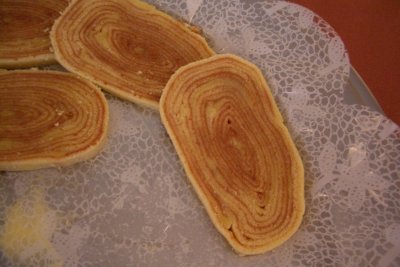 This morning's session was on effects of pollution on meiofauna, which interested David less, so we slept in, breakfasted at leisure, and strolled over to the meetings about 9:15 a.m. The most interesting feature of the morning's breakfast buffet was that the tapioca and rice puddings had been replaced by a great steaming cauldron of whole hominy in a sweetened creamy sauce stewed with cinnamon sticks. Delicious! They also served "bolo de rollo," the spiral cake roll I described earlier ("bolo" means "cake").
This morning's session was on effects of pollution on meiofauna, which interested David less, so we slept in, breakfasted at leisure, and strolled over to the meetings about 9:15 a.m. The most interesting feature of the morning's breakfast buffet was that the tapioca and rice puddings had been replaced by a great steaming cauldron of whole hominy in a sweetened creamy sauce stewed with cinnamon sticks. Delicious! They also served "bolo de rollo," the spiral cake roll I described earlier ("bolo" means "cake").
We lingered a few extra minutes to shop for postcards at the hotel's souvenir shop, and we were able to buy postage for them at the same place.
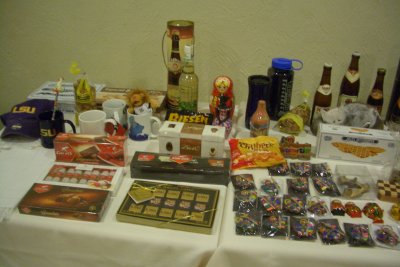
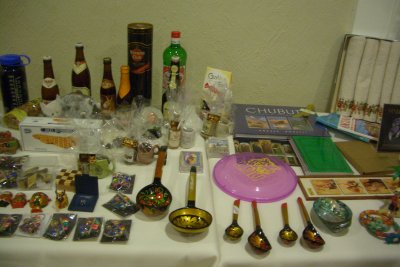 Despite our late arrival, the pollution session was popular and lively. And the raffle prices continue to accumulate. As you can see from these photos, some potables have showed up after all, most of them small enough either to be drunk up before the winner travels or to be packed in a suitcase. The gray ceramic cat is lurking (in the photo to the right) behind the box of cookies and in front of the beer bottles. Unfortunately, it seems to be the consensus first choice, so the first winner is likely to take it.
Despite our late arrival, the pollution session was popular and lively. And the raffle prices continue to accumulate. As you can see from these photos, some potables have showed up after all, most of them small enough either to be drunk up before the winner travels or to be packed in a suitcase. The gray ceramic cat is lurking (in the photo to the right) behind the box of cookies and in front of the beer bottles. Unfortunately, it seems to be the consensus first choice, so the first winner is likely to take it.
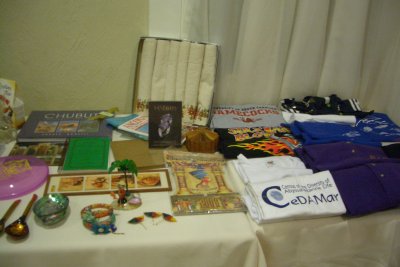 Lunch today was amazing—Thursday must be "regional foods" day, because the buffet included a very high number of items that the management couldn't translate and just described as "regional food with . . ." seafood sauce, tapioca, ground manioc, or whatever. The pasta dish was spaghetti with "dried beef cream sauce," but it wasn't creamed chipped beef but the local sun-dried "jerked" beef, separated into long chewy shreds. "Regional food with seafood sauce" was "maxixe" (oval green objects about the size of limes) in a coconut-based sauce with shrimp—"maxixe" turns out to be a sort of summer squash, covered with tiny soft spines (originally introduced from Africa, I'm told). "Regional food with fish sauce" was a soft, slightly glutinous, clear greenish purée with bits of cooked celery and finely flaked fish in it. "Regional food with ground manioca" was a sort of shepherd's pie, where the shredded stewed beef was topped with manioc rather than potatoes. Turkey in graviola sauce (translated "in regional fruit sauce") was okay but nothing special. "Feijoada" was simply translated "black beans." "Ground casava" was bright yellow but was otherwise very similar to soft mashed potato. The two kinds of fish were just labeled "fish" but were very different. The one I tried could have been very moist tuna. The vegetable salads included, among many others, iceberg lettuce with strawberries and black sesame seeds, cold cooked okra, and a mixture of diced ham and hominy. On the dessert table were a repeat of that great guava bavarian, together with two colors of coconut fudge (amazingly sweet by itself but great with a squeeze of lime), a "cuzcuz de tapioca" (moist crumbly tapioca grains mixed with coconut shreds and pressed into a cake, coconut flan, and many others.
Lunch today was amazing—Thursday must be "regional foods" day, because the buffet included a very high number of items that the management couldn't translate and just described as "regional food with . . ." seafood sauce, tapioca, ground manioc, or whatever. The pasta dish was spaghetti with "dried beef cream sauce," but it wasn't creamed chipped beef but the local sun-dried "jerked" beef, separated into long chewy shreds. "Regional food with seafood sauce" was "maxixe" (oval green objects about the size of limes) in a coconut-based sauce with shrimp—"maxixe" turns out to be a sort of summer squash, covered with tiny soft spines (originally introduced from Africa, I'm told). "Regional food with fish sauce" was a soft, slightly glutinous, clear greenish purée with bits of cooked celery and finely flaked fish in it. "Regional food with ground manioca" was a sort of shepherd's pie, where the shredded stewed beef was topped with manioc rather than potatoes. Turkey in graviola sauce (translated "in regional fruit sauce") was okay but nothing special. "Feijoada" was simply translated "black beans." "Ground casava" was bright yellow but was otherwise very similar to soft mashed potato. The two kinds of fish were just labeled "fish" but were very different. The one I tried could have been very moist tuna. The vegetable salads included, among many others, iceberg lettuce with strawberries and black sesame seeds, cold cooked okra, and a mixture of diced ham and hominy. On the dessert table were a repeat of that great guava bavarian, together with two colors of coconut fudge (amazingly sweet by itself but great with a squeeze of lime), a "cuzcuz de tapioca" (moist crumbly tapioca grains mixed with coconut shreds and pressed into a cake, coconut flan, and many others.
Just now, as I sit typing in the meeting room, waiting for the afternoon session to begin, the hotel's AV guys are helping the speakers set up their PowerPoint presentations and using the otherwise idle sound system to play classic rock and roll. In the last few minutes they've gone through
Run-around Sue, Rock Around the Clock, La Bamba, Twist Like We Did Last Summer, Great Balls of Fire, and many that I didn't know.
Later . . .
This afternoon, the topic is meiofauna taxonomy/systematics, and I was astonished when Rony Huys, a leading copepod taxonomist, mentioned that Arthur Humes (former editor of Journal of Crustacean Biology and apparently a terrifically skilled and prolific crustacean taxonomist) is one of his heros! Arthur Humes is one of my heros. He was a fabulous journal editor, and his revision of a manuscript submitted to the journal by Larry Abele back in the 1980's—after I had already made many corrections to it—was a major turning point in my career as an editor. I remember staring at it in astonishment and thinking, "so that's how it's done!" I borrowed that marked-up manuscript after the paper went back to the journal, and on to be published, and I studied it line by line, with growing admiration and delight. My editing style, and my confidence in my ability to improve constructions that weren't actually wrong, took a great stride forward, and the influence of Humes's editorial style still shows in my work today.
Written 8 August 2007
At the afternoon break, I got to try yet another new tropical fruit juice—pitanga (Eugenia uniflora, Myrtaceae). It's in the blueberry family, but the juice looks and tastes pretty much like Hawaiian punch. At that break, we also learned the sad fate of David's poster. Because the poster easels were essentially large whiteboards, the poster couldn't be mounted with pins or tacks. Those who had attached hangers to their posters could simply suspend them from little hooks at the top, but for those who hadn't (the majority), the organizers supplied wide clear tape. When the time came for the easel suppliers to come back for their easels, they didn't want to risk marring the surfaces by pulling the tape off, so they applied liberal amounts of some organic solvent or other, which took the tape right off the easels but, unfortunately, also took the ink right off the posters! Oh, well. One less thing to carry home.
After the break came the Meiobenthological Society business meeting, at which new officers are electe, the perennial discussion of how to get more money into the Svedmark Fund is conducted, and the all-important announcement is made—where will the next meeting (the fourteenth in this case, Fourtimco? XIVimco?) be held? This time, it is (May I have the envelope, please?)—Ghent! Hooray! That's where the fifth meeting ("Vimco") was held in 1983, and it was great. They're even going to try to schedule it for the week before Ghent's annual festival! And it's handy to France! I don't get a vote, not actually being a member of the society, but I'm delighted at the outcome.
As soon as the business meeting ended, we headed back to our hotel to drop off our extra stuff, then caught the bus that had been arranged to take us all down the beach to a rather grander churrasco restaurant than we visited last night, for the meeting's closing banquet. The banquet, which includes the drawing for the Svedmark Fund raffle, the traditional limerick-writing contest, and sometimes dancing on tables, is always a blast, and this one was right up among the best (although no one danced on tables or even sang raucously).
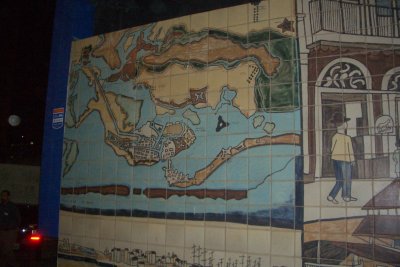
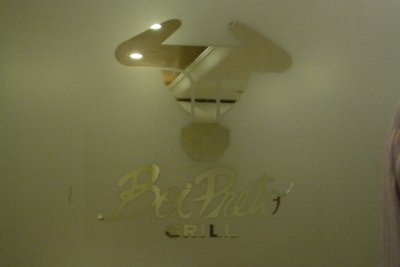 As we got out of the buses, we were greated by a block-long tiled mural, of which this is perhaps one-eighth, showing an antique map of downtown Recife. As we entered, I got this shot of a frosted-glass divider showing the name and logo of the restaurant, Boi Preto (I don't know what "preto" means, but "boi" is "cow"). We were all shown directly upstairs to the banquet room, reserved for our group for the night, where the raffle prizes had already been laid out.
As we got out of the buses, we were greated by a block-long tiled mural, of which this is perhaps one-eighth, showing an antique map of downtown Recife. As we entered, I got this shot of a frosted-glass divider showing the name and logo of the restaurant, Boi Preto (I don't know what "preto" means, but "boi" is "cow"). We were all shown directly upstairs to the banquet room, reserved for our group for the night, where the raffle prizes had already been laid out.
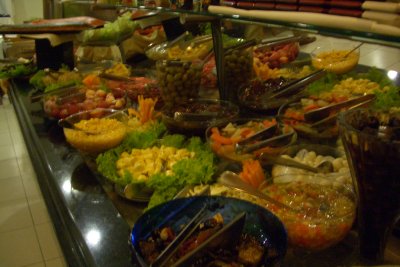
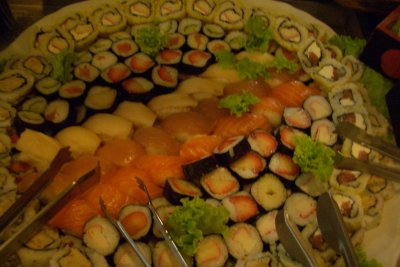
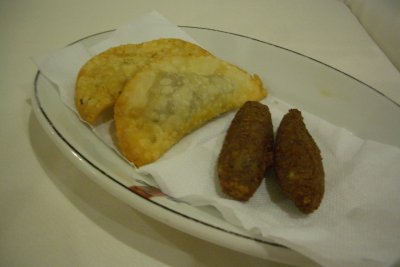
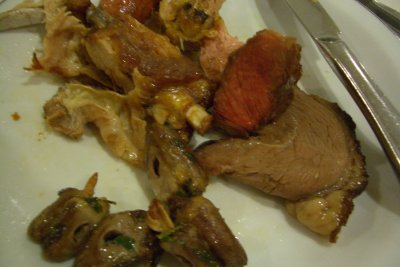 Inside, sure enough, it was like Fogo de Brasa, only bigger and more elaborate. My photos show maybe a quarter of the salad bar, the platter of sushi offered as part of the salad bar (note, nestled in among the more traditional kinds, the strawberry sushi, which is apparently quite popular around here), a plate of hot appetizers (many of which were scattered around the tables; shown here are two crisp fried empanadas and two "quibe"—the same little meat-and-bulgur fingers we were served at the poster reception and clearly cognate with "kibbeh"), and my plate partway through the proceedings (loaded with a couple of cuts of beef, some chicken hearts, some pork ribs, and I think you can see a bit of a sausage up near the top)—only a snapshot of the continually changing pile of meat in front of each of us. In addition to the guys strolling around dispensing meat, others came around ladling out several different flavors of rice (plain, cheese, bean, etc.), fried bananas, potatoes, and what have you.
Inside, sure enough, it was like Fogo de Brasa, only bigger and more elaborate. My photos show maybe a quarter of the salad bar, the platter of sushi offered as part of the salad bar (note, nestled in among the more traditional kinds, the strawberry sushi, which is apparently quite popular around here), a plate of hot appetizers (many of which were scattered around the tables; shown here are two crisp fried empanadas and two "quibe"—the same little meat-and-bulgur fingers we were served at the poster reception and clearly cognate with "kibbeh"), and my plate partway through the proceedings (loaded with a couple of cuts of beef, some chicken hearts, some pork ribs, and I think you can see a bit of a sausage up near the top)—only a snapshot of the continually changing pile of meat in front of each of us. In addition to the guys strolling around dispensing meat, others came around ladling out several different flavors of rice (plain, cheese, bean, etc.), fried bananas, potatoes, and what have you.
When we had all eaten more meat than I would have said we could, the limerick readings began, and this year's crop was exceptional, especially because most of the authors weren't even native speakers of English! For my money, the winner was the Belgian student who wrote a tribute to his major professor (a terrific lady and a long-time and popular member of the society; she'll host the 2010 meetings), in which he joked about her being a blond but no dummy and of which the first letters of the five lines spelled out her name, Magda.
Then came the Svedmark raffle. Every year, the executive committee argues endlessly about how to maximize its fund-raising potential—Do you make more money if you charge more for the tickets or if you make the tickets cheap, so that people buy more of them? This year, they decided on 2 euros, 3 dollars, or 5 Brazilian reais per ticket. (The society maintains separate treasuries in the U.S. and Europe, and it's a great convenience of the meetings that payments for anything—society dues, meal tickets, registration fees, whatever— can be made in dollars, euros, or the local currency if it's not one of those.) And would the whole thing be more profitable as an auction rather than a raffle? (The argument continues over the years, but the one thing the entire society seems to agree on, without exception, is the importance of getting every possible penny into the Svedmark Fund, to keep those starving grad students coming to the meetings—this year, about seven students received financial assistance.) Anyway, this year, when the first ticket was drawn (by the colleague who won my cookbook three years ago, in Ravenna), the winner chose not the ceramic cat but the big coffee-table book about Chubut. The second ticket drawn went to our friend John Fleeger from LSU, a firm advocate of the auction model. Instead of choosing a prize from the table, he took the microphone, held up the winning ticket, and offered to sell it to the highest bidder, proceeds to the Svedmark fund! Bids flew, each bidder specifying currency as well as amount, but David outbid all the competition (contributing handsomely to the fund in the process) and carried off the ceramic cat! The cat is shown here, back in Tallahasse, in two perspectives.
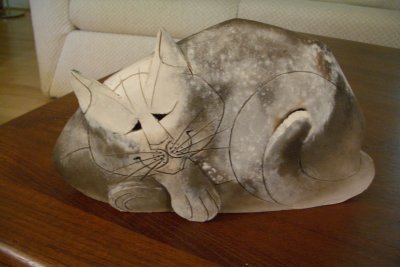
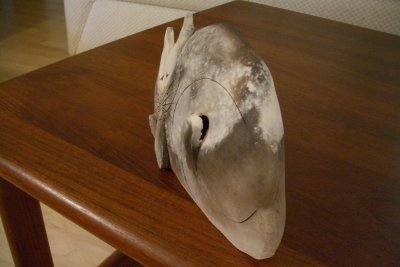 John's gesture opened the floodgates. In the past, when one person won several times (as I did in Ravenna, winning six times), he would often start giving the winning tickets away to others at his table, but otherwise, people more or less claimed their prizes and that was that. This time, though, the next ten or so winners auctioned their tickets for the benefit of the fund. When the value of the prizes began to diminish and bidding flagged, another whole series of people chose prizes and gave them away—visitors to the meeting organizers for their yeoman service, major professors to students who had done them proud in delivering papers, some just to friends known to covet a particular prize. Between us, David and I collected four prizes, which is how we came to bring home, as souvenirs of Brazil, a ceramic cat from Athens, Ohio (about 1 foot long by 6 inches high), and an LSU coffee mug.
John's gesture opened the floodgates. In the past, when one person won several times (as I did in Ravenna, winning six times), he would often start giving the winning tickets away to others at his table, but otherwise, people more or less claimed their prizes and that was that. This time, though, the next ten or so winners auctioned their tickets for the benefit of the fund. When the value of the prizes began to diminish and bidding flagged, another whole series of people chose prizes and gave them away—visitors to the meeting organizers for their yeoman service, major professors to students who had done them proud in delivering papers, some just to friends known to covet a particular prize. Between us, David and I collected four prizes, which is how we came to bring home, as souvenirs of Brazil, a ceramic cat from Athens, Ohio (about 1 foot long by 6 inches high), and an LSU coffee mug.
To contribute dollars to the Svedmark Fund, contact North American treasurer Jyotsna ("Jo") Sharma. To contribute euros, contact European treasurer Ann Vanreusel. To contribute an item for the next raffle/auction (to be held in the summer of 2010 at the meetings in Ghent, Belgium), contact meeting organizer Magda Vincx. And thanks, on behalf of the students the fund is designed to help—they are the future of the meiofauna research.
previous entry
List of Entries
next entry
 This morning's session was on effects of pollution on meiofauna, which interested David less, so we slept in, breakfasted at leisure, and strolled over to the meetings about 9:15 a.m. The most interesting feature of the morning's breakfast buffet was that the tapioca and rice puddings had been replaced by a great steaming cauldron of whole hominy in a sweetened creamy sauce stewed with cinnamon sticks. Delicious! They also served "bolo de rollo," the spiral cake roll I described earlier ("bolo" means "cake").
This morning's session was on effects of pollution on meiofauna, which interested David less, so we slept in, breakfasted at leisure, and strolled over to the meetings about 9:15 a.m. The most interesting feature of the morning's breakfast buffet was that the tapioca and rice puddings had been replaced by a great steaming cauldron of whole hominy in a sweetened creamy sauce stewed with cinnamon sticks. Delicious! They also served "bolo de rollo," the spiral cake roll I described earlier ("bolo" means "cake").
 Despite our late arrival, the pollution session was popular and lively. And the raffle prices continue to accumulate. As you can see from these photos, some potables have showed up after all, most of them small enough either to be drunk up before the winner travels or to be packed in a suitcase. The gray ceramic cat is lurking (in the photo to the right) behind the box of cookies and in front of the beer bottles. Unfortunately, it seems to be the consensus first choice, so the first winner is likely to take it.
Despite our late arrival, the pollution session was popular and lively. And the raffle prices continue to accumulate. As you can see from these photos, some potables have showed up after all, most of them small enough either to be drunk up before the winner travels or to be packed in a suitcase. The gray ceramic cat is lurking (in the photo to the right) behind the box of cookies and in front of the beer bottles. Unfortunately, it seems to be the consensus first choice, so the first winner is likely to take it. Lunch today was amazing—Thursday must be "regional foods" day, because the buffet included a very high number of items that the management couldn't translate and just described as "regional food with . . ." seafood sauce, tapioca, ground manioc, or whatever. The pasta dish was spaghetti with "dried beef cream sauce," but it wasn't creamed chipped beef but the local sun-dried "jerked" beef, separated into long chewy shreds. "Regional food with seafood sauce" was "maxixe" (oval green objects about the size of limes) in a coconut-based sauce with shrimp—"maxixe" turns out to be a sort of summer squash, covered with tiny soft spines (originally introduced from Africa, I'm told). "Regional food with fish sauce" was a soft, slightly glutinous, clear greenish purée with bits of cooked celery and finely flaked fish in it. "Regional food with ground manioca" was a sort of shepherd's pie, where the shredded stewed beef was topped with manioc rather than potatoes. Turkey in graviola sauce (translated "in regional fruit sauce") was okay but nothing special. "Feijoada" was simply translated "black beans." "Ground casava" was bright yellow but was otherwise very similar to soft mashed potato. The two kinds of fish were just labeled "fish" but were very different. The one I tried could have been very moist tuna. The vegetable salads included, among many others, iceberg lettuce with strawberries and black sesame seeds, cold cooked okra, and a mixture of diced ham and hominy. On the dessert table were a repeat of that great guava bavarian, together with two colors of coconut fudge (amazingly sweet by itself but great with a squeeze of lime), a "cuzcuz de tapioca" (moist crumbly tapioca grains mixed with coconut shreds and pressed into a cake, coconut flan, and many others.
Lunch today was amazing—Thursday must be "regional foods" day, because the buffet included a very high number of items that the management couldn't translate and just described as "regional food with . . ." seafood sauce, tapioca, ground manioc, or whatever. The pasta dish was spaghetti with "dried beef cream sauce," but it wasn't creamed chipped beef but the local sun-dried "jerked" beef, separated into long chewy shreds. "Regional food with seafood sauce" was "maxixe" (oval green objects about the size of limes) in a coconut-based sauce with shrimp—"maxixe" turns out to be a sort of summer squash, covered with tiny soft spines (originally introduced from Africa, I'm told). "Regional food with fish sauce" was a soft, slightly glutinous, clear greenish purée with bits of cooked celery and finely flaked fish in it. "Regional food with ground manioca" was a sort of shepherd's pie, where the shredded stewed beef was topped with manioc rather than potatoes. Turkey in graviola sauce (translated "in regional fruit sauce") was okay but nothing special. "Feijoada" was simply translated "black beans." "Ground casava" was bright yellow but was otherwise very similar to soft mashed potato. The two kinds of fish were just labeled "fish" but were very different. The one I tried could have been very moist tuna. The vegetable salads included, among many others, iceberg lettuce with strawberries and black sesame seeds, cold cooked okra, and a mixture of diced ham and hominy. On the dessert table were a repeat of that great guava bavarian, together with two colors of coconut fudge (amazingly sweet by itself but great with a squeeze of lime), a "cuzcuz de tapioca" (moist crumbly tapioca grains mixed with coconut shreds and pressed into a cake, coconut flan, and many others.
 As we got out of the buses, we were greated by a block-long tiled mural, of which this is perhaps one-eighth, showing an antique map of downtown Recife. As we entered, I got this shot of a frosted-glass divider showing the name and logo of the restaurant, Boi Preto (I don't know what "preto" means, but "boi" is "cow"). We were all shown directly upstairs to the banquet room, reserved for our group for the night, where the raffle prizes had already been laid out.
As we got out of the buses, we were greated by a block-long tiled mural, of which this is perhaps one-eighth, showing an antique map of downtown Recife. As we entered, I got this shot of a frosted-glass divider showing the name and logo of the restaurant, Boi Preto (I don't know what "preto" means, but "boi" is "cow"). We were all shown directly upstairs to the banquet room, reserved for our group for the night, where the raffle prizes had already been laid out.


 Inside, sure enough, it was like Fogo de Brasa, only bigger and more elaborate. My photos show maybe a quarter of the salad bar, the platter of sushi offered as part of the salad bar (note, nestled in among the more traditional kinds, the strawberry sushi, which is apparently quite popular around here), a plate of hot appetizers (many of which were scattered around the tables; shown here are two crisp fried empanadas and two "quibe"—the same little meat-and-bulgur fingers we were served at the poster reception and clearly cognate with "kibbeh"), and my plate partway through the proceedings (loaded with a couple of cuts of beef, some chicken hearts, some pork ribs, and I think you can see a bit of a sausage up near the top)—only a snapshot of the continually changing pile of meat in front of each of us. In addition to the guys strolling around dispensing meat, others came around ladling out several different flavors of rice (plain, cheese, bean, etc.), fried bananas, potatoes, and what have you.
Inside, sure enough, it was like Fogo de Brasa, only bigger and more elaborate. My photos show maybe a quarter of the salad bar, the platter of sushi offered as part of the salad bar (note, nestled in among the more traditional kinds, the strawberry sushi, which is apparently quite popular around here), a plate of hot appetizers (many of which were scattered around the tables; shown here are two crisp fried empanadas and two "quibe"—the same little meat-and-bulgur fingers we were served at the poster reception and clearly cognate with "kibbeh"), and my plate partway through the proceedings (loaded with a couple of cuts of beef, some chicken hearts, some pork ribs, and I think you can see a bit of a sausage up near the top)—only a snapshot of the continually changing pile of meat in front of each of us. In addition to the guys strolling around dispensing meat, others came around ladling out several different flavors of rice (plain, cheese, bean, etc.), fried bananas, potatoes, and what have you.